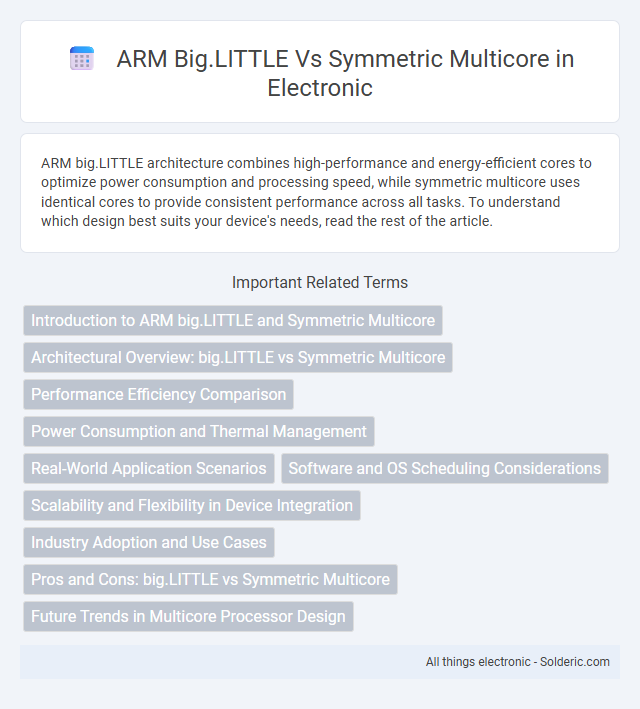ARM big.LITTLE architecture combines high-performance and energy-efficient cores to optimize power consumption and processing speed, while symmetric multicore uses identical cores to provide consistent performance across all tasks. To understand which design best suits your device's needs, read the rest of the article.
Comparison Table
| Feature | ARM big.LITTLE | Symmetric Multicore |
|---|---|---|
| Architecture Type | Heterogeneous (big and LITTLE cores) | Homogeneous (identical cores) |
| Core Types | High-performance (big) + energy-efficient (LITTLE) | All cores are the same high-performance type |
| Power Efficiency | Optimized for power saving by switching cores dynamically | Uniform power consumption across all cores |
| Performance | Balanced performance optimized per workload | Consistent performance across all cores |
| Task Scheduling | Dynamic task migration between big and LITTLE cores | Tasks evenly distributed to all identical cores |
| Use Cases | Mobile devices, power-sensitive applications | Servers, desktops, applications requiring uniform performance |
| Design Complexity | Higher due to heterogeneous core management | Simpler due to homogeneous cores |
Introduction to ARM big.LITTLE and Symmetric Multicore
ARM big.LITTLE architecture pairs high-performance cores with energy-efficient cores to optimize power consumption and performance dynamically. Symmetric multicore processors feature identical cores that share workloads evenly, ensuring consistent performance across all tasks. Your choice between ARM big.LITTLE and symmetric multicore depends on the balance you need between energy efficiency and processing power for specific applications.
Architectural Overview: big.LITTLE vs Symmetric Multicore
ARM big.LITTLE architecture combines high-performance cores with power-efficient cores, switching dynamically to optimize energy use without sacrificing performance. Symmetric multicore designs feature identical cores that share workloads evenly, prioritizing simplicity and consistent performance. Your choice between big.LITTLE and symmetric multicore influences application efficiency and power consumption depending on workload characteristics.
Performance Efficiency Comparison
ARM big.LITTLE architecture combines high-performance cores with energy-efficient cores to optimize workload distribution, enhancing performance efficiency by dynamically switching between cores based on task demand. In contrast, symmetric multicore systems use identical cores that offer consistent performance but may lack the fine-grained power efficiency seen in big.LITTLE setups. Your choice depends on the need for balancing peak performance with battery life, as big.LITTLE excels in extending efficiency without sacrificing load responsiveness.
Power Consumption and Thermal Management
ARM big.LITTLE architecture optimizes power consumption by combining high-performance cores with energy-efficient cores, allowing the system to dynamically switch workloads to the appropriate core type based on demand. This selective core usage reduces overall thermal output and enhances thermal management compared to symmetric multicore processors, which run all cores at similar power levels regardless of workload. As a result, big.LITTLE designs achieve improved energy efficiency and better control over heat dissipation in mobile and embedded devices.
Real-World Application Scenarios
ARM big.LITTLE architecture excels in real-world application scenarios requiring a balance of performance and power efficiency by dynamically switching between high-power cores for demanding tasks and energy-saving cores for lighter workloads. Symmetric multicore processors deliver consistent performance across all cores, making them ideal for parallel processing tasks and applications that require uniform computational power. Your choice depends on whether your workload favors energy efficiency and task-level optimization or sustained multi-threaded performance.
Software and OS Scheduling Considerations
ARM big.LITTLE architecture requires advanced software and OS scheduling strategies to dynamically allocate tasks between high-performance big cores and energy-efficient LITTLE cores, optimizing power efficiency and performance based on workload demands. In contrast, symmetric multicore systems run identical cores, simplifying OS scheduling by uniformly distributing tasks without prioritizing cores for specific performance or power profiles. Effective scheduling on big.LITTLE platforms hinges on workload characterization and real-time monitoring to balance responsiveness and energy usage, whereas symmetric multicore scheduling emphasizes load balancing and minimizing contention.
Scalability and Flexibility in Device Integration
ARM big.LITTLE architecture enhances scalability by combining high-performance cores with energy-efficient ones, enabling dynamic workload distribution that maximizes power savings without sacrificing speed. Symmetric multicore processors deploy identical cores, simplifying software optimization but potentially limiting flexibility in balancing performance and energy usage for diverse device scenarios. Your choice influences device integration flexibility, where big.LITTLE suits heterogeneous workloads demanding adaptive power management, while symmetric multicore excels in uniform task environments requiring consistent processing power.
Industry Adoption and Use Cases
ARM big.LITTLE architecture is extensively adopted in mobile devices, offering dynamic workload distribution between high-performance and power-efficient cores, optimizing battery life and processing power. Symmetric multicore processors find wide use in servers and desktops, providing consistent performance across cores ideal for multitasking and parallel computing workloads. Industry sectors prioritize big.LITTLE for energy efficiency in smartphones and IoT devices, while symmetric multicore suits data centers and high-performance computing for scalability and uniform core performance.
Pros and Cons: big.LITTLE vs Symmetric Multicore
ARM big.LITTLE architecture combines high-performance cores with energy-efficient cores, offering a balance between power and efficiency by dynamically switching between cores based on workload, which leads to improved battery life and reduced heat generation. Symmetric multicore designs use identical cores, simplifying software development and providing consistent performance across tasks but often at the cost of higher power consumption and less optimized energy use. Your choice depends on whether you prioritize energy efficiency with varied workloads (big.LITTLE) or straightforward, predictable performance in uniform tasks (symmetric multicore).
Future Trends in Multicore Processor Design
Future trends in multicore processor design emphasize energy efficiency and workload adaptability, with ARM big.LITTLE architecture offering heterogeneous cores that optimize performance by dynamically switching between high-power and low-power cores. Symmetric multicore designs maintain identical cores for simpler software management but face limitations in power efficiency for diverse workloads. Your choice will depend on balancing power consumption and execution speed as mobile and edge computing continue to demand smarter, adaptive processing solutions.
ARM big.LITTLE vs symmetric multicore Infographic

 solderic.com
solderic.com